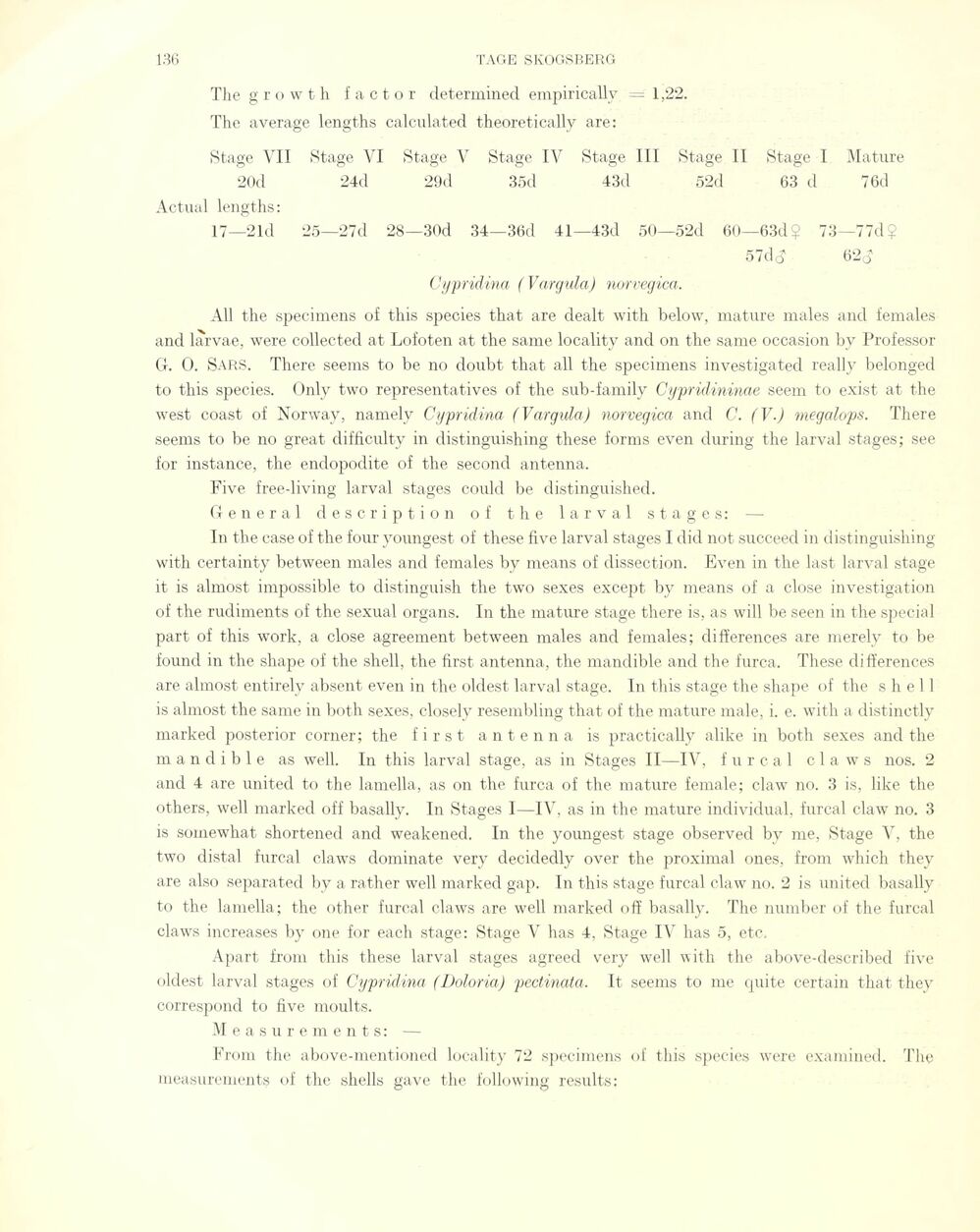
Full resolution (JPEG) - On this page / på denna sida - Sidor ...

<< prev. page << föreg. sida << >> nästa sida >> next page >>
Below is the raw OCR text
from the above scanned image.
Do you see an error? Proofread the page now!
Här nedan syns maskintolkade texten från faksimilbilden ovan.
Ser du något fel? Korrekturläs sidan nu!
This page has never been proofread. / Denna sida har aldrig korrekturlästs.
The g r o w t h factor determined empirically = 1,22.
The average lengths calculated theoretically are:
Stage VII Stage VI Stage V Stage IV Stage III Stage II Stage I Mature
20d 24(1 29d 35d 43d 52d 63 d 76d
Actual lengths:
17—21d 25—27d 28—30d 34—36d 41—43d 50—52d 60—63d? 73—77d?
57d(J 62J
Cypridina ( Vargula) norvegica.
All the specimens of this species that are dealt with below, mature males and females
and larvae, were collected at Lofoten at the same localitv and on the same occasion by Professor
G. O. Sars. There seems to be no doubt that all the specimens investigated really belonged
to this species. Only two representatives of the sub-family Cypridininae seem to exist at the
west coast of Norway, namely Cypridina (Vargula) norvegica and C. (V.) niegalops. There
seems to be no great difficulty in distinguishing these forms even during the larval stages; see
for instance, the endopodite of the second antenna.
Five free-living larval stages could be distinguished.
General description of the larval stages: —
In the case of the four youngest of these five larval stages I did not succeed in distinguishing
with certainty between males and females by means of dissection. Even in the last larval stage
it is almost impossible to distinguish the two sexes except by means of a close investigation
of the rudiments of the sexual organs. In the mature stage there is, as will be seen in the special
part of this work, a close agreement between males and females; differences are merely to be
found in the shape of the shell, the first antenna, the mandible and the furca. These differences
are almost entirelv absent even in the oldest larval stage. In this stage the shape of the shell
is almost the same in both sexes, closely resembling that of the mature male, i. e. with a distinctly
marked posterior corner; the first antenna is practically alike in both sexes and the
mandible as well. In this larval stage, as in Stages II—IV, furcal c 1 a w s nos. 2
and 4 are united to the lamella, as on the furca of the mature female; claw no. 3 is, like the
others, well marked off basally. In Stages I—IV, as in the mature individual, furcal claw no. 3
is somewhat shortened and weakened. In the youngest stage observed bv me. Stage V, the
two distal furcal claws dominate very decidedly over the proximal ones, from which they
are also separated by a rather well marked gap. In this stage furcal claw no. 2 is united basally
to the lamella; the other furcal claws are well marked off basally. The number of the furcal
claws increases by one for each stage: Stage V has 4, Stage IV has 5, etc,
Apart from this these larval stages agreed very well with the above-described five
oldest larval stages of Cypridina (Doloria) pectinata. It seems to me quite certain that they
correspond to five moults.
Measurements: —
From the above-mentioned locality 72 specimens of this species were examined. The
measurements of the shells gave the folio wing results;
<< prev. page << föreg. sida << >> nästa sida >> next page >>